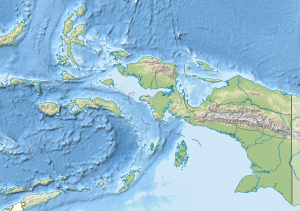Waigeo
| Waigeo | ||
|---|---|---|
| Drummers in the village of Waifoy on Waigeo | ||
| Waters | Lake Halmahera , Pacific Ocean | |
| Archipelago | Raja Ampat | |
| Geographical location | 0 ° 12 ′ S , 130 ° 50 ′ E | |
|
|
||
| length | 125 km | |
| width | 55 km | |
| surface | 3 155 km² | |
| Highest elevation | Samlor 1000 m |
|
| Residents | 1667 <1 inh / km² |
|
| main place | Wasai | |
| Raja Ampat Islands with Waigeo in the north | ||
Waigeo (also Amberi or Waigiu ) is 3155 km² and is the largest of the four main islands of the Raja Ampat archipelago off the coast of western New Guinea ( Indonesia ).
geography
Waigeo is located in the north of the archipelago, about 65 km northwest of New Guinea's Bird Head Peninsula . By Mayalibit Bay (Mayalibit Bay), which is only accessible via a narrow strait, Waigeo is divided into a western and an eastern half. Waigeo measures around 125 km in east-west direction and around 55 km in north-south direction.
In the south of the western part of Waigeos lies the Kabuy Bay ( Indonesian Teluk Kabuy ), which is enclosed on three sides by the island. To the south, the bay is protected by the island of Gam , which is only separated from Waigeo by a narrow waterway to the west of the bay, but by a larger entrance to the south. South of Waigeo and Gam lies the Dampier Strait with the islands of Mansuar and Kri , and beyond the Strait of Batanta and Salawati . To the north are the islands of Ayau , Waiag Islands and Kawe , which also belong to the group . The archipelago belongs to the Raja Ampat administrative district of the West Papua Province . The city of Wasai (also Waisai ) in the south of the western part of Waigeos is the capital of the administrative district.
The highest point of Waigeo is the Samlor with about 1000 m . The interior of the island is covered by mostly untouched rainforest, with a high biodiversity. More than 250,000 hectares of rainforest are officially protected in the two “Wildlife Reserves” of West and East Waigeo.
Residents
The 1667 inhabitants only settle on the shores of the bay and on some of the small islands of Mayalibit Bay. They have largely retained their traditional lifestyle and feed on locally caught fish and wild boar as well as cocoa, fruits, herbs and spices that are grown or gathered in the forest. Often the Papuans obtain a starch from the pulp of the sago palm as a staple food.
history
The Portuguese navigator Jorge de Meneses was the first European to land on Waigeo in 1526. In the 19th century, the island and the surrounding waters were explored by French expeditions, including the ships L'Uranie (1818-1819), La Coquille (1823) and L'Astrolabe (1826). About 70 species of fish were found.
Web links
- Forest development and conservation on Waigeo, West Papua. On: geo.de. Retrieved March 18, 2014.
Individual evidence
- ^ Richard Stephen Whiteway: The Rise of Portuguese Power in India (1497-1550) . Susil Gupta, London 1989, ISBN 81-206-0500-4 (first edition: 1967).
- ↑ Gerald Allen, Mohammed Adrim: Coral Reef Fishes of Indonesia . In: Zoological Studies . tape 42 , no. 1 , 2003.


